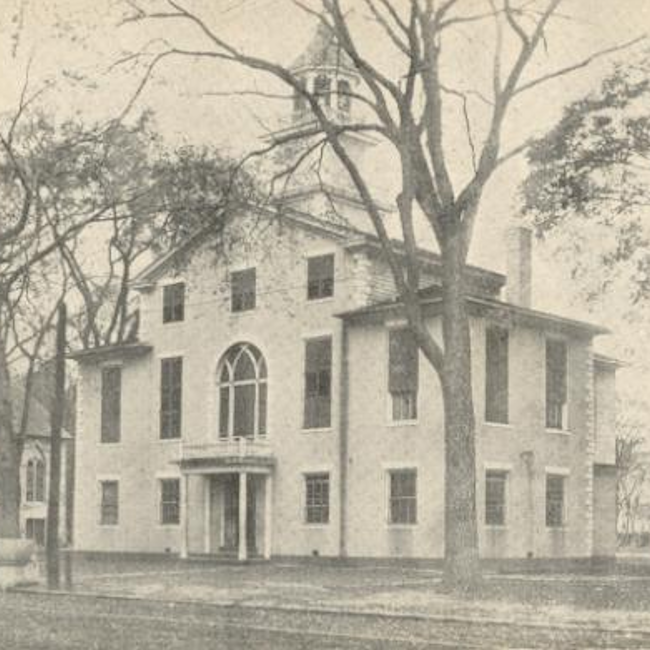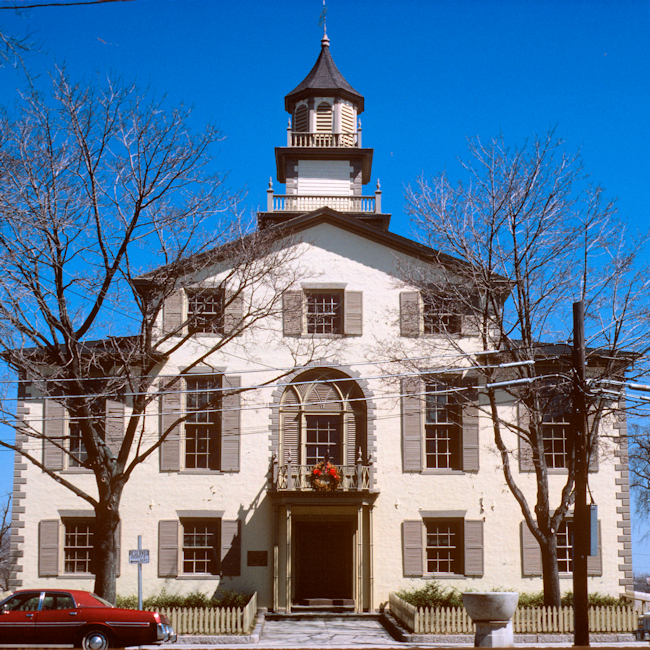The Bristol Statehouse County Courthouse is the third building to stand upon this site on the Bristol Town Common. By 1684, a Meeting House was erected here and part of the lands now occupied by the Statehouse were used as burial sites. This church was removed in the 18th century and in 1791 a private school, known as the Academy, was erected. This remained on site until it was moved further south on the Common to make room for the present building (it was later cut in half, moved off the Common altogether and exists today as two private homes). All in all, this has made this western portion of the Common an interesting location. Details of this story was uncovered in the archeological dig that occurred before the construction of the small wing on the east of the original structure—both the grave shafts for 18 sites and the original chimney base of the Academy were partially uncovered and then preserved under the new el.
In 1814, the Rhode Island General Assembly ordered the old courthouse on State St. to be sold because of its deteriorating condition. What followed was a competition between Warren and Bristol for the new building. Warren cleared and offered a small site between Church Street and State Street. (the present day Common behind Jamiel’s), but the General Assembly decided to accept Bristol’s offer of a preeminent site, 200′ by 200′ on the Bristol Common, facing the harbor, the main means of transportation at that time.
The architect of the building is unknown. On February 27, 1816, “L. Rousmaniere for the Committee” noted that “…a plan for a courthouse (has been) furnished by a gentleman of acknowledged judgement & experience in building with stone (which unites cheapness with durability) & who gave it as his opinion that said plan can be carried into erection and the courthouse completed in a workmanlike manner for $7,000.00.” Unfortunately, none of the official state records regarding the building give the names of the individuals involved in the building, though there are strong architectural, stylistic and political reasons to think it was designed by Russell Warren, the favorite of the powerful DeWolf family.
The May 20, 1816 handwritten and unsigned specifications for the building exist at the State Archives in Providence. Calling for its completion before June of 1817, it states that it should be according to the plan submitted which, however, does not exist in the Archives. It calls for the use of “good Taunton, well burnt, square Brick, and the Brick to be headed in every eighth course and to be substantially built; the Brick to be of as good a quality as those of the Bristol Hotel in Bristol….The middle window in front of the upper story to be completed according to the intent and meaning of the Architect who drew the plan of the front…” The document goes on to include information on the windows, the interior woodwork and floors, and even specifies the exact materials that are to be used (floors of “good pine, spruce, oak or chestnut” roof to be covered with the “first quality of Connecticut or North River pine shingles…”). The General Assembly voted some additional funds for a gallery in the Courtroom in early 1817 and by February of 1818, the building was formally accepted by the State, though later that year they did approve funds for both the bell and the construction of an outhouse.
The original design of the interior of the building had a central staircase leading to a platform and split risers to the second floor. The existing rooms on the north and south were both one window larger and there was a wall running north/south to enclose the courtroom area. This obviously did not serve the growing needs of the State, so a major redesign was financed in 1836 that created most of the interior spaces we recognize today. The stairs were pushed to the north side of the building and the much larger courtroom, with balcony, was created. Additionally, a larger meeting space was created on the first floor that served as a town meeting room. Lastly, the exterior Federal bricks were covered with stucco and scored and painted to resemble large stone blocks, the fashionable Greek Revival style of the period.
The building basically stayed the same from that time on, though it received gas lighting in 1855 and two small wings were added in 1871. Changes such as the addition and removal of shutters, the removal of the chimneys and the addition of the exterior granite curbs were gradually introduced. The last major visible change was in the 1930s when architect Wallis E. Howe removed the original portico and added the current cast iron, gothic one. Finally, the Bristol Statehouse Foundation made a major addition to the rear (west) of the building to add an elevator, fire stairs and accessible restrooms. With all the work and use the building had through the years, until this addition there was only one way in and out, and only one wooden staircase.




